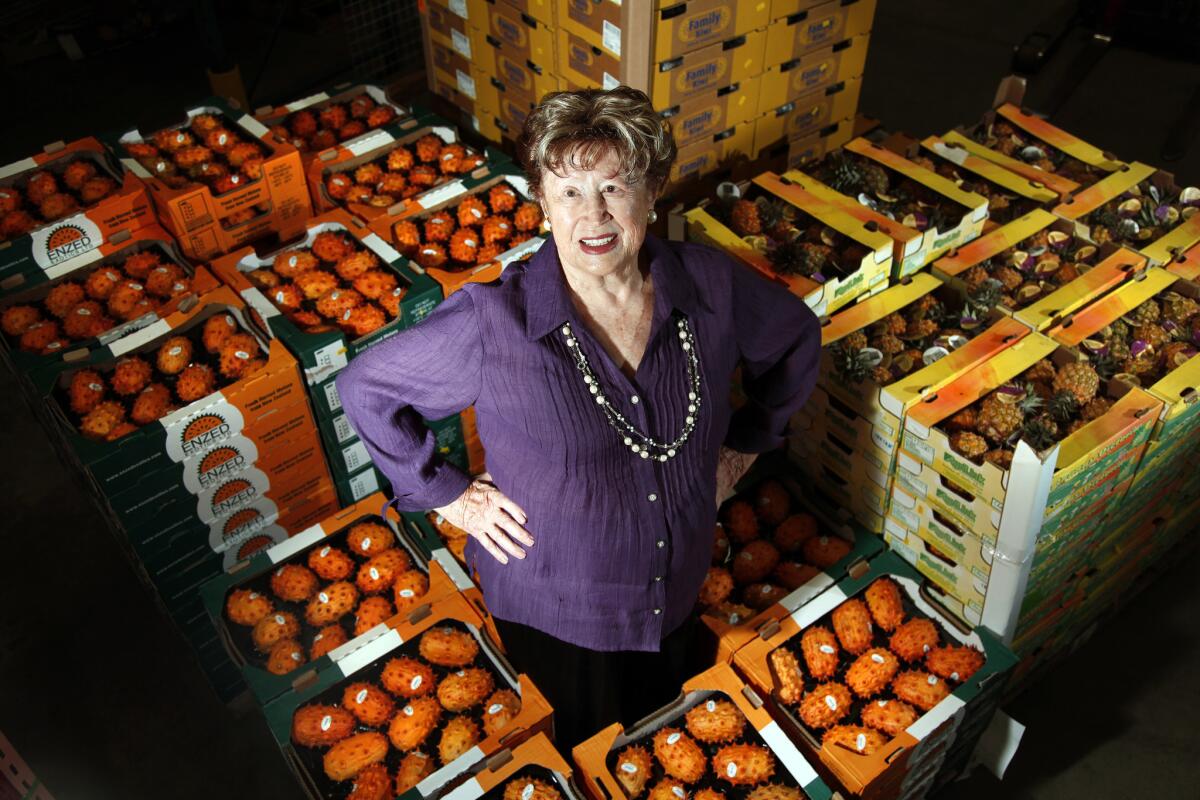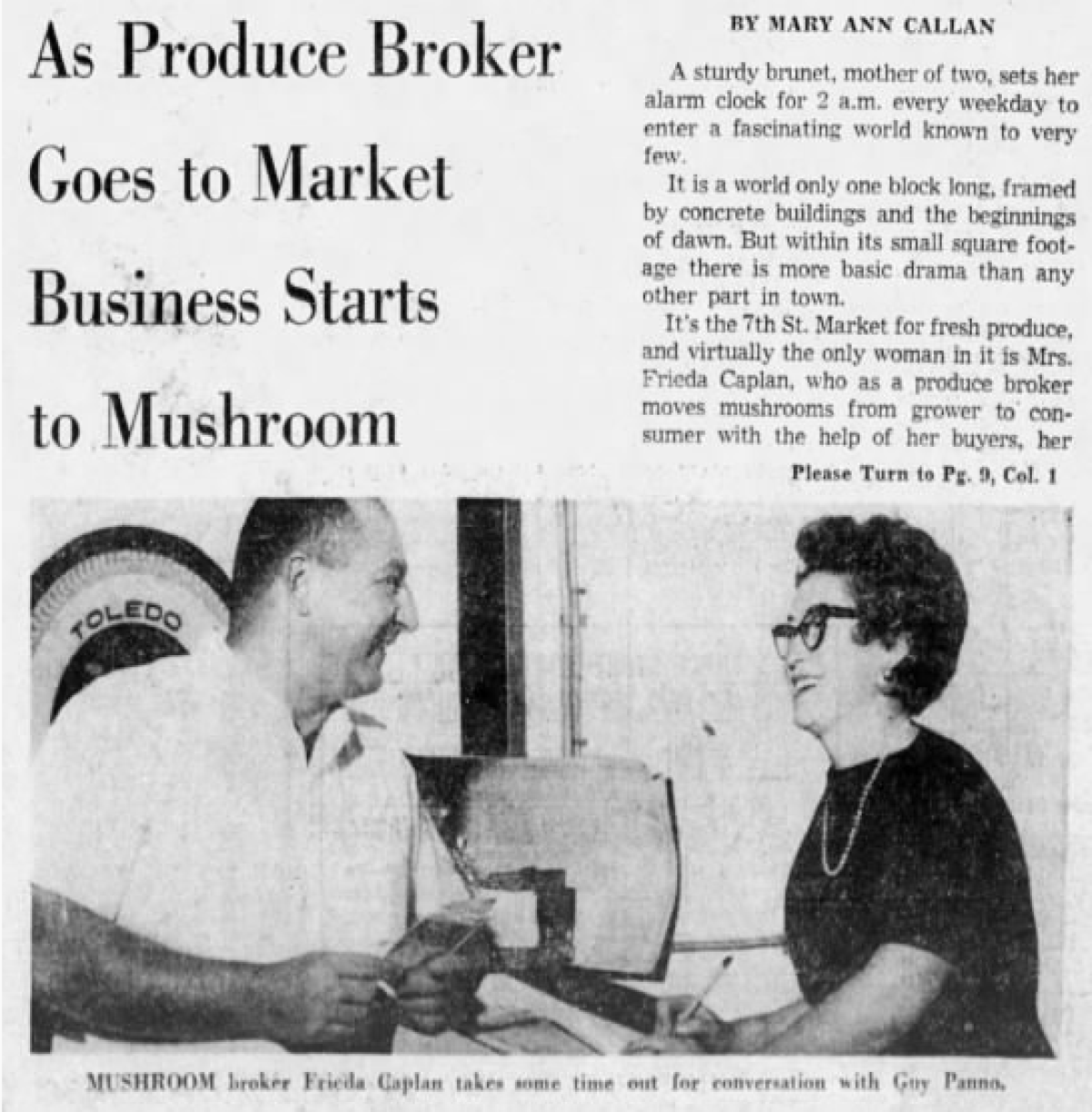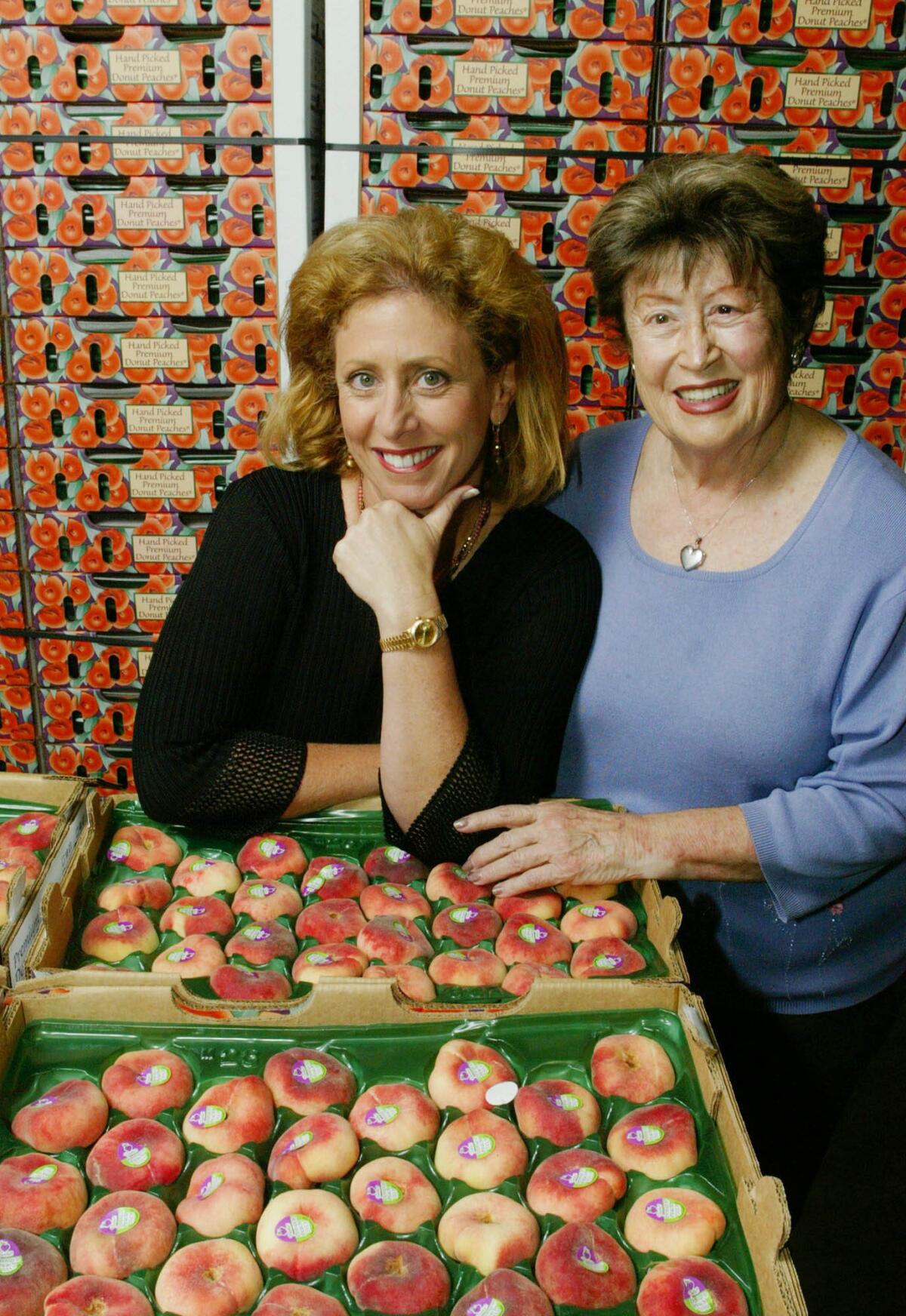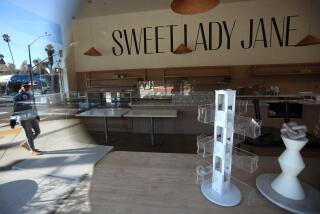‘Kiwi Queen’ Frieda Caplan, produce-industry pioneer, dies at 96

- Share via
They called her “Kiwi Queen” and “Mother Gooseberry.” “Mushroom Lady” and “the “Mick Jagger of the produce world.” The woman who broke the glass ceiling in the testosterone-doused produce world and forever changed the way Americans eat fruits and vegetables.
She was Frieda Rapoport Caplan, a tenacious maven credited for introducing kiwis, mangoes, habanero and shishito peppers, passion fruit, bean and alfalfa sprouts, baby carrots, sugar snap peas, starfruit, blood oranges, shiitake mushrooms, turmeric, and hundreds more fruits and vegetables into the supermarket mainstream. Into the bellies of American consumers.
She was loquacious, driven and loved to take risks.
“I had a reputation of trying anything new,” she told the Pasadena Star-News in 2003. “I couldn’t compete with all the boys on the big items … so I built the business selling things that were different.”
That was the Caplan way, a gritty business owner deemed the first woman to own and run her own produce house in Los Angeles’ Wholesale Produce Market and the U.S.
In heels and a skirt, she revolutionized the way the produce world did business, adding recipes and cooking instructions on packages of “exotic” produce to tame the distrust of an unsuspecting public.
Caplan died Saturday morning in Los Alamitos after a brief illness, according to an email sent by her daughters, Karen Caplan — president and CEO of Frieda’s Specialty Produce — and Jackie Caplan Wiggins, the company’s chief operating officer. She was 96.
“Who the hell had heard of jicama or spaghetti squash?” said Ben Faber, a UC Cooperative Extension farm advisor who works with specialty crops. “We were a meat and potatoes society in the 1960s,” he added. “She changed our eating habits.... Frieda was able to tap into aspirations that people had after the Second World War ... something new and different other than mac ‘n’ cheese.”
Born in 1923 in downtown L.A., Caplan was the daughter of Russian immigrants and raised in Highland Park. Like many great success stories, Caplan’s stratospheric rise as the mother and pioneer of specialty produce came from happenstance.
The year was 1945, and Caplan had recently graduated from UCLA with a degree in economics and political science. Soon after, she landed an office gig working for an attorney who headed the CIO’s political action committee in L.A.
In 1951, she married labor consultant and president of a longshoreman’s union, Alfred Hale Caplan. Four years later, they had their firstborn, Karen.
She started searching for a job with flexible hours, as she wanted to care for and breastfeed her baby at home. Her husband’s uncle and aunt, who managed a produce house, happened to be looking for a bookkeeper, so they brought Caplan on board.
Then her boss went on vacation, and Caplan was asked to fill in as a cashier. As buyers came in for produce, the young Caplan nudged them toward a pallet of fresh brown mushrooms. One man agreed, but his order was massive, and they didn’t have enough in stock to fill his request.
She panicked.
Everyone she called was out of the fungi, so she went hunting for them at the Ocean View Mushroom Farm in Orange County. They too were sold out, but she saw employees packing mushrooms and lent a hand.
She got what she wanted and filled the buyer’s request.
It was a steady trajectory from there as Caplan developed her marketing expertise.
Encouraged by the manager for the Southern Pacific Railroad, which ran the market, Caplan launched her own business with the help of a loan from her father, focusing on overlooked foodstuffs.
“The other people on the market were only interested in high-volume items,” Caplan once said. “Small farmers had no place to go. Nobody was interested. So I started listening to all these small farmers.”

And slowly, her reputation for selling fruits and vegetables no one had heard of stateside had swelled.
“Go to Frieda,” growers and buyers often heard when they sought an offbeat product no one knew about.
The kiwi, Caplan’s first claim to fame, made its debut after a Safeway buyer asked if she carried “Chinese gooseberries,” which he’d encountered on a recent trip to New Zealand.
She didn’t. But months later, a broker walked through the market with a box and Caplan bought some. She renamed the brown fuzzy edible kiwifruit, thinking customers would find its new name more appealing.
It took nearly a decade for the fruit to popularize. “I like to call it our 18-year overnight success,” she once said. Ironically, she grew allergic to the fruit in her later years.
“Her introduction of kiwi made people less risk-averse to try new things,” said Marianne McGarry Wolf, head of Cal Poly San Luis Obispo’s Agribusiness Department.
Gradually, Caplan carved out a niche for herself. After hustling for years, working from 1 a.m. to 5 p.m. daily, Caplan founded her own company in 1962. Purple became her signature color because, at the time of her business launch, it was the only hue the sign maker she hired had on hand.
“There have always been exotic food items,” Caplan told The Times in 1972 on the key to success. “We just showcased them, dressed them up and sold them.”
She even supplied the “alien” fruits for “Star Trek” episodes, which helped boost sales.
Also a sales success was her introduction of packaged produce, an idea that spawned when customers in Chicago couldn’t tell the difference between the ginger and sunchokes they’d purchased from her.
So Caplan found a solution: She labeled their products and added a note telling customers to call Frieda’s for recipes and more information. “We were flooded with letters,” Caplan said in the 2015 documentary “Fear No Fruit.” Every week, they received 400 to 800 letters.
“Success came because I never saw obstacles,” she told the Orange County Register in 2018.
In the mid-1980s, when Frieda’s Inc. had established itself as an industry leader, she told The Times that her success was due to the health and fitness craze of the time, medical reports stating that eating more fresh produce showed a lower cancer rate, and a spurt of restaurants specializing in fresh and exotic foods.
Before long she was supplying produce to stores like Vons, Ralphs, Trader Joe’s, Bristol Farms and Whole Foods.
The media had long ago taken notice of her, and had been following her rocketing career.
The Times in 1990 listed Caplan as one of a dozen Californians — including Steve Jobs and Jane Fonda — who shaped American businesses in the 1980s.
“You gotta hand it to her,” said an admirer to The Times in 1972. “She made something from nothing. There isn’t a produce man in the market who doesn’t take his hat off to her.”
And throughout her long, fruitful life and career, others took their hats off to her, too.
Her many accolades included an honorary degree of Doctor of Humane Letters from Cal Poly San Luis Obispo; a Lifetime Achievement Award from United Fresh Produce Assn.; a Legacy Award from National Assn. of Women Business Owners; received the first Working Woman’s magazine’s first Harriet Alger Award for Entrepreneurship; and was the first woman to receive The Packer newspaper’s “Produce Man of the Year” in the 1970s, which she rejected until it was renamed “The Produce Marketer of the Year.”
By 2018, Frieda’s, Inc. had boomed into a $50-million-plus business with 75 full-time and 110 part-time employees, an 81,000-square-foot warehouse in Los Alamitos and customers from across the world.
Until recently, Caplan still showed up to work. Cane in hand, always donning purple, she filed invoices and kept a keen eye on the next big product, leaving her daughters Karen and Jackie to run the business.
“She works like someone is keeping time on her,” her granddaughter and the company’s sales manager Alex Berkley once said.
But despite all her innovations and accomplishments, her accolades and title as “the marketing genius who galvanized the California farm industry and almost singlehandedly created fruit and vegetable trends,” as many described her, there’s one thing Caplan didn’t do: She never learned how to cook.

More to Read
Start your day right
Sign up for Essential California for the L.A. Times biggest news, features and recommendations in your inbox six days a week.
You may occasionally receive promotional content from the Los Angeles Times.








